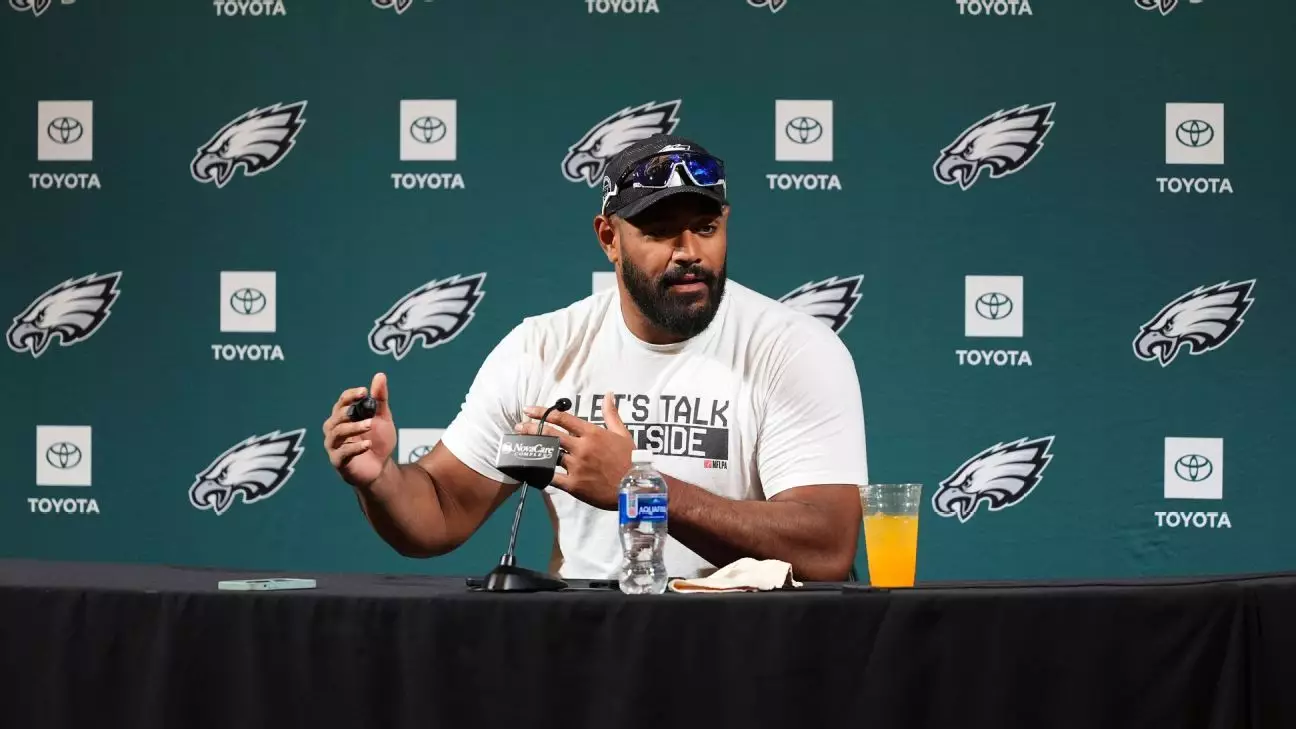In the ever-evolving landscape of the NFL, one maneuver has captured both attention and scrutiny: the ‘tush push.’ Originating as a mere tactic to gain a yard or two, the play has sparked significant debate, particularly among the coaching tactics of the Philadelphia Eagles. As proclaimed by Eagles wide receiver A.J. Brown, it seems trivial — “It’s only 1 yard.” However, this seemingly simple play has become an integral feature of their offensive strategy. What underpins this controversial technique, and why has it drawn the ire of some teams within the league?
The tush push is more than just a short-yardage play; it symbolizes the dichotomy of traditional versus modern approaches in football. By employing a setup where players line up strategically behind the quarterback for an assisted sneak, the Eagles have demonstrated that brute strength combined with unified teamwork can outsmart defenses. It’s a chess game where innovative strategies reign supreme. But as discussions from NFL owners loom regarding a potential ban on this play, there’s an air of tension that questions whether success should be penalized, or revered.
The Stance of Eagles Players on Proposed Changes
With the impending vote to potentially outlaw the tush push, the sentiments of key players reflect a dismissive attitude toward the change. Left tackle Jordan Mailata humorously stakes his claim by dismissing the name itself, indicating his focus lies more in the execution of their offensive schemes than in the politics surrounding a single play. “I hate that name, so I hope they do ban it – it’s a stupid name,” he quipped, lotting a moment of levity amidst a tense discussion. Such nonchalance emanating from the Eagles players suggests a confidence in their adaptability; they are fixated on honing their gameplay rather than being bogged down by external regulations that could disrupt their routine.
For coach Nick Sirianni, the issue transcends a simple rule change. He articulated concerns about fairness, accusing rival teams of attempting to leverage rule modifications simply to impede the Eagles’ effectiveness. This is where the spirit of competition wrestles with bureaucratic interventions. Sirianni, urging for a more dynamic approach, posits that banning a play simply due to its success may stifle the creativity that football thrives upon.
Statistics Highlighting the Effectiveness of the Tush Push
Numbers speak volumes in sports, and the performance metrics relating to the tush push are impressive. Over the last three seasons, the Eagles and the Buffalo Bills have proliferated the use of this tactic, achieving a staggering success rate of 87% in converting first downs or touchdowns during their attempts. Comparatively speaking, the rest of the league has only managed a 71% success rate. This disparity not only emphasizes the proficiency of the Eagles in executing the play but also questions the legitimacy of restricting a method that works well for some while falling short for others.
Nonetheless, the ongoing fracas calls into question the governance of play-calling in the NFL. Should certain successful strategies be open to modification simply because they complicate defensive strategies for other teams? The discussion is reminiscent of debates in other sports ondebated modifications either emphasize or hinder competitive balance.
Broader Implications for NFL Strategy and Culture
The tussle over the tush push reflects a deeper ideological divide within football culture itself. It emphasizes the ongoing tension between innovation and tradition. The question arises: do we remain loyal to longstanding norms, or do we embrace the innovations that make the sport exciting? The potential ban transcends a mere play; it reaches into the essence of strategic evolution that defines modern football.
NFL owners and coaches must reflect on the consequences of implementing rules that aim to curtail creativity. The game should evolve and adapt rather than revert to a static approach ruled by nostalgia. Players like Jalen Hurts, who possess both the physicality and understanding of the game necessary to execute such plays, represent the embodiment of future football—agile, strategic, and steeped in teamwork.
As the vote approaches, the discussions surrounding the tush push will undoubtedly continue to reverberate throughout the league, shaping not just tactical play, but the very nature of competitive spirit in the NFL.

